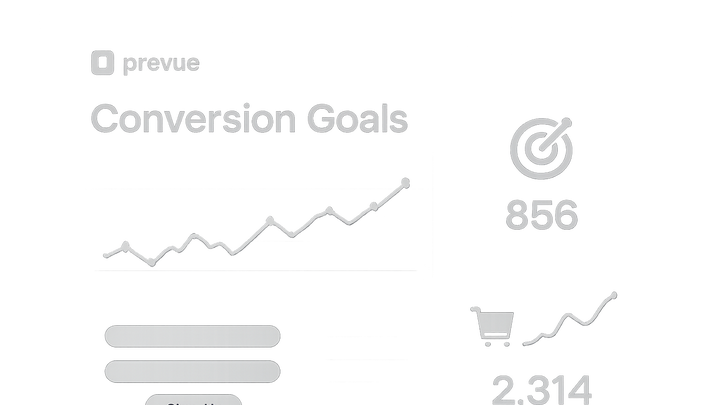Published on 2025-06-29T19:59:53Z
What is a Conversion Goal? Examples for CRO, UX, and SEO
Conversion Goal refers to a specific action you want users to take on your website, such as completing a purchase, signing up for a newsletter, or downloading a whitepaper. In the fields of conversion rate optimization (CRO), user experience (UX), and SEO, defining clear conversion goals is essential for measuring the success of your online efforts and aligning with your business objectives.
Conversion goals help you track performance and identify areas for improvement across marketing channels. Tools like Prevue.me can analyze your site’s CRO, lead generation, SEO, UX, and accessibility, providing actionable critiques to help you optimize toward your goals. By setting SMART (Specific, Measurable, Achievable, Relevant, Time-bound) conversion goals, you can create focused strategies, improve user journeys, and increase overall ROI.
Effective conversion goals also enable data-driven testing, segmentation analysis, and continuous optimization. They serve as a compass for A/B tests, UX redesigns, and content improvements. Without well-defined goals, it’s difficult to know if your changes are driving measurable impact or simply cosmetic enhancements.
Ultimately, conversion goals transform qualitative insights into quantitative growth. They allow teams to speak a common language around success and invest resources where they matter most.
Conversion goal
A Conversion Goal is a defined user action you want on your website, like purchases or signups, essential for CRO, UX, and SEO.
Definition and Context
Conversion goals represent the primary actions you need users to complete to achieve your business objectives. In CRO, UX, and SEO, these goals focus your optimization efforts, enabling clear measurement and targeted improvements.
-
Core concept
A conversion goal is a user action aligned with business outcomes, such as purchases, signups, downloads, or form submissions.
Importance of Conversion Goals
Well-defined conversion goals provide a clear benchmark for success, guide resource allocation, and ensure all teams work toward the same objectives.
-
Aligns marketing and business objectives
Conversion goals link website performance to revenue and growth targets, ensuring campaigns deliver tangible results.
-
Guides ux design
Understanding desired user actions informs layout, navigation, and content decisions to streamline the path to conversion.
-
Drives data-driven decisions
Tracking goal completions enables A/B testing, experimentation, and continuous optimization based on real user behavior.
Setting Effective Conversion Goals
Use the SMART framework to define goals that are Specific, Measurable, Achievable, Relevant, and Time-bound.
-
Specific action
Clearly define the exact user action—for example, “Complete checkout” or “Download eBook”.
- Form submission:
Tracking when a visitor fills out and submits a contact or signup form.
- Email signup:
Monitoring newsletter or drip campaign subscriptions.
- Trial activation:
Measuring when users start a free trial or demo.
- Form submission:
-
Measurable metrics
Assign numeric values to your goals—e.g., 500 new signups per month or a 5% cart conversion rate.
- Use analytics tools:
Implement Google Analytics, prevue.me, or other platforms to track goal completions.
- Define targets:
Set clear numeric targets to gauge success.
- Use analytics tools:
-
Achievable & relevant
Ensure goals are realistic given your traffic and resources, and directly support your broader business strategy.
-
Time-bound
Specify a deadline—such as quarterly or monthly—to create urgency and enable periodic reviews.
Tools and Examples
Leverage specialized SaaS and analytics platforms to define, monitor, and optimize conversion goals.
-
Prevue.me critiques
Get actionable CRO, lead generation, SEO, UX, and accessibility feedback tailored to your conversion goals.
-
Google analytics goals
Set up destination, duration, event, or pages-per-session goals to track conversions directly in GA.
-
Hotjar funnels
Visualize drop-off points in multi-step processes to identify bottlenecks in your conversion path.
Measuring and Optimizing
Continuously track, analyze, and refine your conversion goals to drive incremental improvements.
-
A/b testing
Compare variations to see which design or copy yields the highest conversion rate.
- Design tests:
Experiment with layouts, colors, and imagery to find the most persuasive combination.
- Copy tests:
Test headlines, button text, and descriptions for maximum clarity and impact.
- Design tests:
-
Segmentation analysis
Break down conversions by audience demographics, traffic source, or behavior to uncover high-value segments.
-
Continuous monitoring
Regularly review KPI dashboards and prevue.me reports to adapt strategies based on fresh data.
